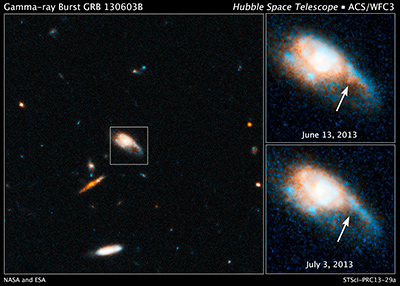
Ever since U.S. Air Force satellites serendipitously discovered gamma-ray bursts in the 1960s, astronomers have been searching for the triggering mechanism. Gamma-ray bursts are mysterious flashes of intense high-energy radiation that appear from random directions in space. These titanic explosions unleash as much energy in less than a second as the Sun does in 1 million years.
Now, astronomers are using NASA's Hubble Space Telescope to gather key evidence on what powers short-duration gamma-ray bursts, which last up to two seconds. Probing the location of a recent short-duration burst in near-infrared light, Hubble found the fading fireball produced in the aftermath of the blast. The afterglow reveals for the first time a new kind of stellar blast called a kilonova, an explosion predicted to accompany a short-duration gamma-ray burst. The kilonova is the "smoking gun" evidence that short-duration bursts are sparked by the merger of two small, super-dense stellar objects, such as a pair of neutron stars or a neutron star and a black hole.
